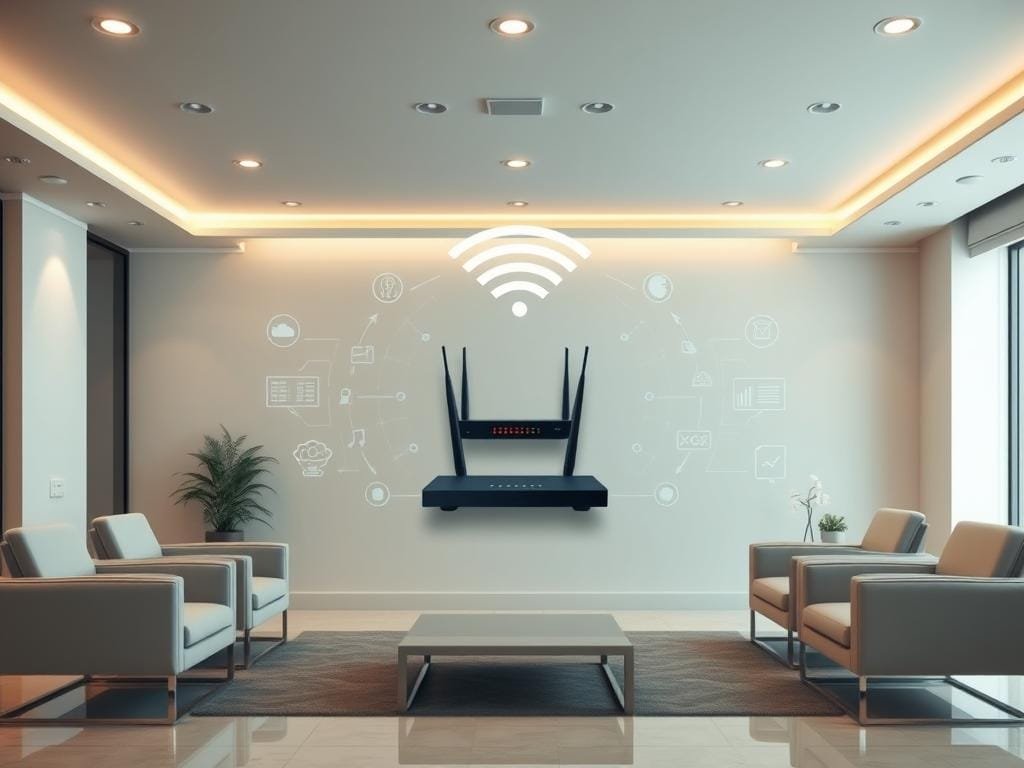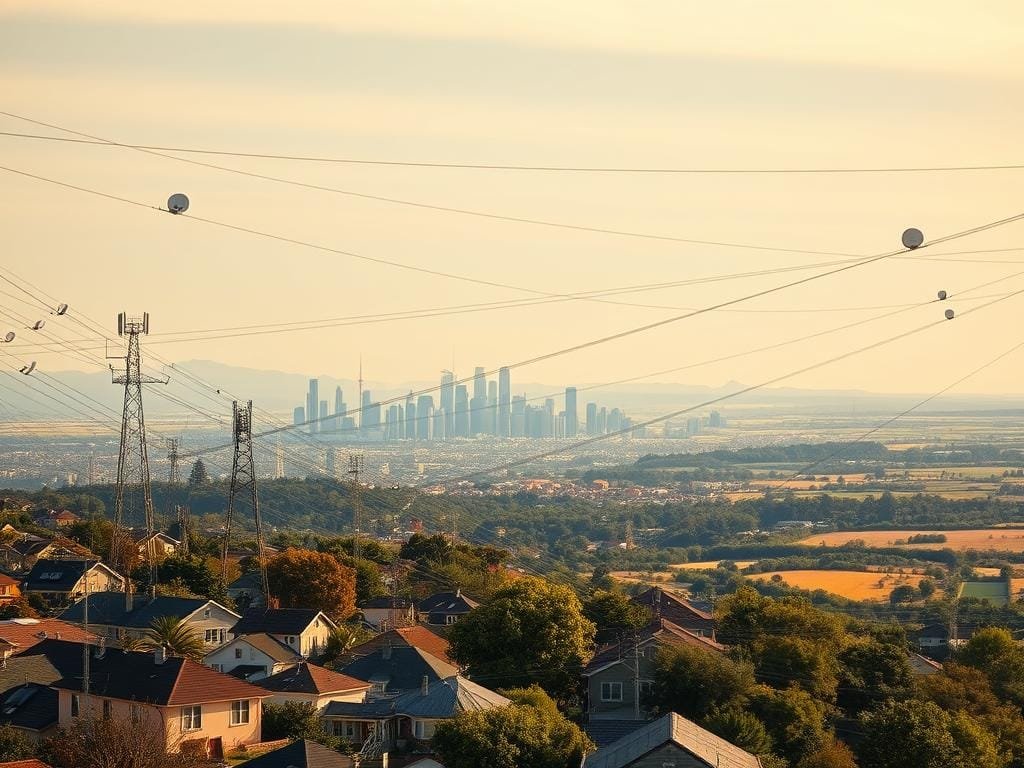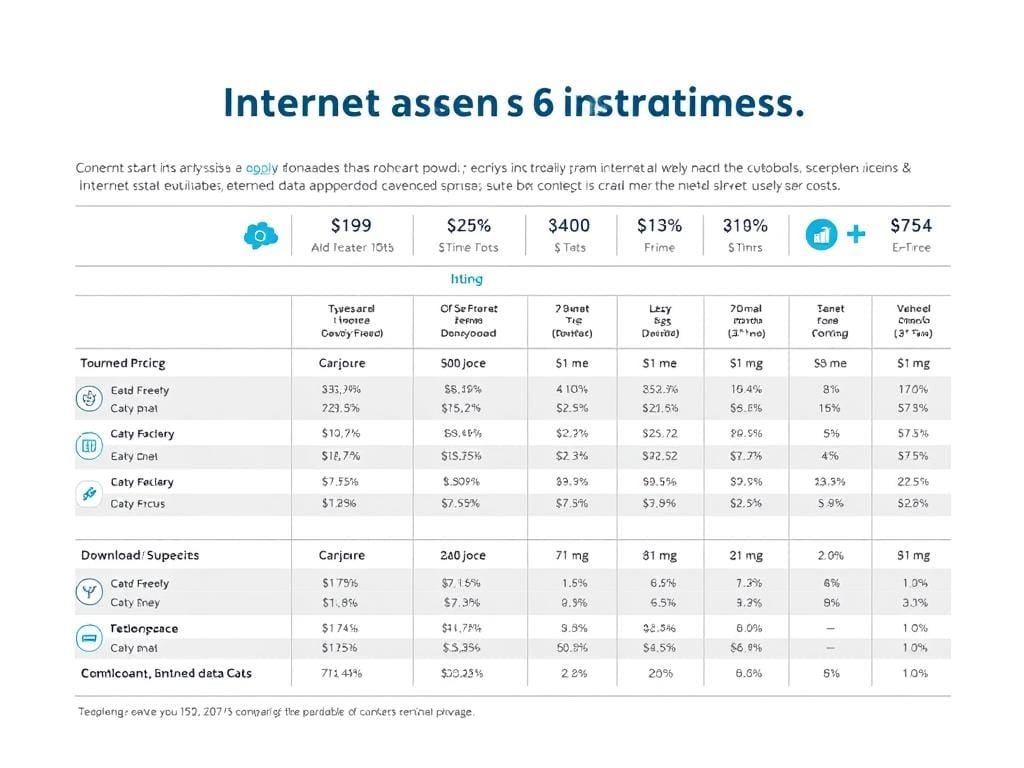Did you know that nearly 40% of households in the United States have multiple devices streaming content at the same time? With more people working from home, learning online, and using streaming services, picking the right high-speed internet plan is now more important than ever.
Choosing the best internet connectivity type can be tough with so many options. You must think about your budget, how you use the internet, and how many devices you need to connect. This guide will help you understand what you need for your high-speed internet.
Key Takeaways
- Understand the different types of high-speed internet available
- Assess your internet usage patterns and needs
- Learn how to choose the best internet plan for your budget
- Discover the importance of internet speed and reliability
- Find out how to future-proof your internet connectivity
Understanding Different Types of Internet Connections
There are many internet connections, each with its own benefits and drawbacks. It’s important to know what’s available to find the best fit for you.
When picking an internet connection, look at what each type offers. You’ll find fiber optic, cable, DSL, and satellite internet. Each has its own strengths and weaknesses.
Fiber Optic: The Fastest Choice
Fiber-optic internet is super fast and reliable. It’s great for heavy users. It uses light in cables for a fast and stable connection.
Fiber-optic internet can handle lots of devices at once without slowing down. But, it might not be available everywhere. Setting it up can also be tricky.
Cable Internet: Widespread and Reliable
Cable internet uses TV cables for broadband access. It’s fast and easy to find, making it popular. It works well for many online activities.
But, cable internet can slow down when lots of people use it. This is because of network congestion.
DSL: Affordable Yet Slower Option
DSL internet uses phone lines for internet. It’s cheaper than other options, which is good for those on a budget.
But, DSL is slower than fiber-optic and cable. Its speed can also depend on how far you are from the provider.
Satellite Internet: Accessibility for Rural Areas
Satellite internet is good for rural areas where other options aren’t available. It uses a dish to connect to satellites in space for wireless internet.
It covers a lot of ground, but weather and latency can be issues. For more info, check out CNET’s guide.
Factors to Consider When Choosing an Internet Connection
When picking an internet plan, think about several key factors. Your choice of internet can greatly affect how you work, play, and talk online.

Speed Requirements for Your Needs
The speed of your internet is very important. Different activities need different speeds. For example, if you just check emails and browse, a slower speed might be okay.
But, if you’re into online gaming, streaming, or downloading big files, you’ll need a faster connection.
To figure out your speed needs, think about how many devices will be online at once. Also, think about what you’ll be doing online. A good rule is to add up your devices and multiply by 25 Mbps for basic use.
Key speed considerations:
- Basic browsing and email: 1-5 Mbps
- Streaming HD video: 5-10 Mbps
- Online gaming: 10-25 Mbps
- Heavy streaming or multiple device use: 50 Mbps or more
Data Caps and Usage Limits
Many internet providers have data caps or usage limits. Going over these can lead to extra charges or slower speeds. It’s important to know how much data you use.
Think about your online habits. Streaming, gaming, and cloud backups use a lot of data. If you use a lot, look for plans with no data caps.
“The average American household uses around 250-500 GB of data per month, but this number can vary greatly depending on individual habits.”
Reliability and Consistency
A reliable internet connection is key for both home and business users. Slow speeds or downtime can be annoying and hurt productivity. When picking a provider, look at their reliability and consistency.
Check if they offer Service Level Agreements (SLAs) or uptime guarantees. Reading reviews and asking for advice can also help you understand a provider’s reliability.
By thinking about speed, data caps, and reliability, you can choose an internet connection that fits your needs.
Comparing Internet Speeds of Different Types
The speed of your internet connection is key to your online life. It affects how well you stream, work from home, or play games online. The type of connection you have matters a lot.
Fiber and cable are often talked about because they’re common and fast. Knowing how they compare can help you choose the best internet for your home.
Fiber vs. Cable: Which is Faster?
Fiber optic internet is the fastest internet connection for most people. It uses light in cables to send data, making it quicker and more reliable than cable. Cable internet, which uses TV cables, is fast but can slow down if many people use it.
If you need super-fast internet for gaming or streaming 4K, fiber is best. But, it’s not always available in rural areas. For more on fast internet, check out https://digitalvistaonline.com/5g-mobile-development/.

Download vs. Upload Speeds Explained
It’s important to know the difference between download and upload speeds. Download speed is how fast data comes to your device, great for streaming and browsing.
Upload speed is how fast data goes from your device to the internet. It’s key for video calls, gaming, and uploading big files. Most people need faster download speeds, but upload speed is also important for some tasks.
When picking an internet plan, think about what you do online. If you stream, game, and work from home, look for a plan with good download and upload speeds. This will make your online experience smooth.
Assessing Your Location’s Internet Options
Understanding your area’s internet options is key to picking the right service. The availability of wireless internet and broadband access changes a lot between cities and countryside. It’s important to know what’s available locally.
Urban vs. Rural Considerations
In cities, you have many ISPs to choose from. They offer fiber-optic, cable, and DSL connections. This competition can lower prices and improve service quality. Many city folks also have access to mesh network systems, which offer great coverage and speed.
But, rural areas have fewer internet choices because of less infrastructure. Satellite internet is often the only option for many, with slower speeds and data limits. Knowing these differences is key when looking at your internet options.

Availability of Providers in Your Area
To find out what internet services are available in your area, start by looking up local ISPs. Websites like HighSpeedInternet.com can help you learn about ISPs and check if they serve your location.
When looking at providers, think about:
- Types of connections they offer (fiber, cable, DSL, satellite)
- Speed and data limits
- Pricing and any special deals
- Customer service and how reliable they are
By looking at these factors, you can choose the best internet service for your needs, whether you live in a city or the countryside.
Cost Analysis of Internet Service Providers
Understanding the full cost of your internet service is key to budgeting well. This includes monthly fees and any extra charges for setup and equipment.

Monthly Costs by Connection Type
The cost of internet varies by connection type. For example, fiber optic internet is pricier than DSL or cable internet. Monthly costs range from $30 to $100, based on provider and speed.
Here’s a quick look at average monthly costs for different connections:
- Fiber Optic: $50-$100
- Cable Internet: $30-$70
- DSL: $20-$50
- Satellite Internet: $50-$150
Hidden Fees and Installation Charges
There are more costs to think about when picking an internet service provider. Installation fees can be $50 to $200, based on setup complexity and if you need a pro.
Some providers also charge for renting equipment like modems or routers. These costs can add up, so include them in your total cost estimate.
To avoid surprise bills, always check the service terms and ask about hidden fees.
Bundled Services: Combining Internet with Other Utilities
Bundled services are becoming more popular. They let you get internet, TV, and phone from one provider. This can make paying bills easier and might save you money. It’s important to check if the bundle fits your needs.
Internet, TV, and Phone Packages
Getting internet, TV, and phone together can be handy. Many providers offer fiber optic internet in their bundles. This means fast and reliable internet. A bundle might include fast internet, lots of TV channels, and phone service that works everywhere.
When looking at these bundles, think about a few things:
- The speed and reliability of the internet
- The variety and quality of TV channels and on-demand content
- The features and coverage of the phone service
A bundle with high-speed internet is great for families or those who stream a lot.
Pros and Cons of Bundled Services
Bundled services have good points and bad points. The good stuff includes:
- Lower costs compared to buying each service separately
- Easier bill payments because everything is in one place
- Improved service quality because everything works together better
The not-so-good stuff includes:
- You might pay for things you don’t use
- It can be hard to get out of a contract if you change your mind
- The total cost might be higher if you pick the wrong bundle
Experts say, “Bundling can save money, but you need to pick the right package for you.”
“The key to benefiting from bundled services is understanding your consumption patterns and selecting a package that closely matches your needs.”
To choose wisely, compare the costs and features of different bundles. Here’s a table to help you see what you might get:
| Bundle Type | Services Included | Typical Cost |
|---|---|---|
| Basic | Internet | $50-$70 |
| Standard | Internet, TV | $80-$120 |
| Premium | Internet, TV, Phone | $120-$180 |
Choosing a bundled service should be based on your needs and comparing options. This way, you can find the best value and meet your high-speed internet and other utility needs.
The Impact of Internet Connection on Your Lifestyle
In today’s world, having a good internet connection is not just nice; it’s essential. It affects many parts of your life. Whether you’re watching your favorite shows, working from home, or playing online games, your internet connection is key to a smooth experience.
Gaming and Streaming Considerations
For gamers and streamers, a fast and reliable internet connection is a must. Low latency and high-speed connections are needed for uninterrupted gaming and streaming. Fiber optic connections are often the best choice because of their speed and low latency.
The type of internet you have can greatly affect your gaming experience. For example, fiber optic connections offer a lag-free experience, while DSL might struggle with modern games. Streamers also need a stable and fast upload speed for high-quality video streams.
Remote Work Efficiency and Video Calls
With more people working from home, a reliable internet connection is vital for productivity. Video conferencing tools like Zoom and Google Meet need stable and fast internet to work well. Slow or unreliable connections can cause dropped calls, pixelated video, and other issues that can slow you down.
For remote workers, a good internet connection is essential for efficient work. It allows for smooth communication, timely file sharing, and trouble-free virtual meetings. When picking an internet connection, remote workers should look for high upload and download speeds and low latency.
In conclusion, the right internet connection can make your digital life better, whether you’re gaming, streaming, working from home, or staying in touch with family. By understanding your needs and choosing the right internet, you can have a more enjoyable and productive online experience.
Future Trends in Internet Connectivity
The internet is changing fast, thanks to new wireless tech and better infrastructure. Knowing about these changes is key to choosing the right internet for you.
Rise of 5G Technology
5G technology is changing how we use the internet. It offers faster speeds and less delay, opening up new possibilities. For example, global 5G coverage is growing, giving you more choices for mobile and fixed wireless internet.
Some benefits of 5G include:
- Faster data transfer rates
- Lower latency for real-time applications
- Increased connectivity for IoT devices
Evolution of Internet Infrastructure
The growth of 5G is also linked to better internet infrastructure. Fiber optic investments are making the fastest internet connection available to everyone. Plus, wireless tech is getting better, covering more areas and saving money.
- Expansion of fiber optic networks for higher speed and reliability
- Advancements in wireless technologies for broader coverage
- Innovations in network management for optimized performance
As these trends keep evolving, you’ll see a stronger, more reliable internet. Keeping up with these changes will help you use the latest tech and services to their fullest.
Making the Final Decision: Tips for Choosing the Right Internet Connection
Choosing the right internet connection is about looking at several key factors. This ensures you get a reliable network. With many options out there, picking the right one is important.
Trial Periods and Customer Feedback
Looking at trial periods and customer reviews can help. Many providers offer trial periods to test their services. Customer reviews also give insights into the provider’s reliability and service quality.
Asking the Right Questions
When picking an internet service provider, ask the right questions. Find out about their plans, including data caps, speeds, and extra fees. Knowing the terms of service and network congestion policies is key.
By looking at these factors and doing your homework, you can pick the best internet for your needs. This ensures a reliable connection from your chosen provider.
FAQ
What is the best type of internet connection for online gaming?
For online gaming, you need a fast and reliable internet connection. Fiber optic internet is often the best choice. It offers high speeds and low latency, perfect for smooth gaming.
How do I determine my internet speed requirements?
Think about how many devices you have online and what you do online. For streaming 4K videos or heavy gaming, you need speeds over 100 Mbps. For simple browsing, 25 Mbps is enough.
What are the differences between fiber, cable, and DSL internet?
Fiber optic internet uses light in cables for fast data transfer. Cable internet uses TV cables for speed but may share bandwidth. DSL internet is slower and can be affected by distance from the provider.
Can I get high-speed internet in rural areas?
High-speed internet can be hard to find in rural areas. Satellite and some wireless providers offer fast connections. But, availability and quality vary by location.
What should I consider when evaluating internet service providers?
Look at speed, data caps, reliability, customer service, and cost. Check if providers are available in your area. Also, read reviews to see how satisfied others are.
Are bundled services a cost-effective option for internet, TV, and phone?
Bundled services can save money if you need internet, TV, and phone. But, compare total costs to individual plans. Some discounts may end after a while.
How do I assess the reliability of an internet connection?
Check the provider’s network and read customer reviews. A good connection has little downtime and steady speeds.
What is the impact of 5G technology on home internet?
5G is mainly for mobile devices but can be a home internet option. It offers fast speeds and low latency. But, availability and suitability vary by location.
How can I ensure I’m making the right choice when selecting an internet plan?
Know your internet needs and compare plans. Consider speed, cost, and reliability. Try trial periods and read reviews to make a good choice.
